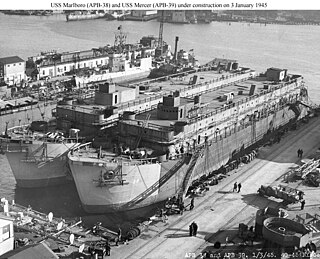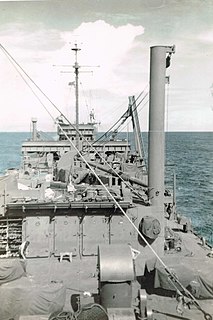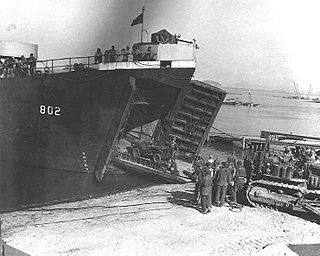
USS Dorchester (APB-46), was a Benewah-class barracks ship. Her hull classification symbol was initially to be LST-1112. She was first redesignated a General Stores Issue Ship (AKS-17) on 8 December 1944, then as a Self-propelled Barracks Ship (APB-46). Her keel was laid down by Missouri Valley Bridge and Iron Company of Evansville, Indiana. She was launched on 12 April 1945 sponsored by Mrs. J.A. Walsh, and commissioned on 15 June 1945, Lieutenant W.T. Roberts, Jr., USNR, in command.

USS Gosselin (APD-126) was a Crosley-class high speed transport of the United States Navy, in service from 1944 to 1949. She was sold for scrap in 1965.

The second USS Mercer is an APL-35-class Barracks ship of the United States Navy. Originally classified as Barracks Craft APL 39, the ship was reclassified as Self-Propelled Barracks Ship APB 39 on 7 August 1944. Laid down on 24 August 1944 by Boston Navy Yard, and launched on 17 November 1944 as APB 39, sponsored by Mrs. Lillian Gaudette, the ship was named Mercer, after counties in eight states, on 14 March 1945, and commissioned on 19 September 1945, Lt. Comdr. Edward E. Vezey, Jr., USNR, in command.

USS Marion County (LST-975) was an LST-542-class tank landing ship built for the United States Navy during World War II. Like many of her class, she was not named and is properly referred to by her hull designation. She was later named after counties in seventeen U.S. states, she was the only US Naval vessel to bear the name.

USS San Bernardino County (LST–1110) was an LST-542-class tank landing ship built for the United States Navy during World War II. Named for San Bernardino County, California, she was the only U.S. Naval vessel to bear the name.

USS Sphinx (ARL-24) was laid down as a United States Navy LST-542-class tank landing ship but converted to one of 39 Achelous-class repair ships that were used for repairing landing craft during World War II. Named for the Sphinx, she was the only US Naval vessel to bear the name.

USS Atlas (ARL-7) was one of 39 Achelous-class landing craft repair ships built for the United States Navy during World War II. Named for Atlas, she was the second U.S. Naval vessel to bear the name.
USS Romulus (ARL-22) was laid down as a United States Navy LST-542-class tank landing ship but converted to one of 39 Achelous-class repair ships that were used for repairing landing craft during World War II. Named for Romulus, she was the only US Naval vessel to bear the name.

USS Typhon (ARL-28) was one of 39 Achelous-class landing craft repair ships built for the United States Navy during World War II. Named for Typhon, she was the only U.S. Naval vessel to bear the name.

USS Sedgwick County (LST-1123) was an LST-542-class tank landing ship in the United States Navy. Unlike many of her class, which received only numbers and were disposed of after World War II, she survived long enough to be named. On 1 July 1955, all LSTs still in commission were named for US counties or parishes; LST-1123 was given the name Sedgwick County, after counties in Colorado and Kansas.

USS Pitkin County (LST-1082) was an LST-542-class tank landing ship built for the United States Navy during World War II. Named after Pitkin County, Colorado, she was the only U.S. Naval Vessel to bear the name.

USS Hamilton County (LST-802) was an LST-542-class tank landing ship built for the United States Navy during World War II. Named after counties in Florida, Illinois, Indiana, Iowa, Kansas, Nebraska, New York, Ohio, Tennessee, and Texas, she was the only U.S. Naval vessel to bear the name.

USS LST-19 was a United States Navy LST-1-class tank landing ship used exclusively in the Asiatic-Pacific Theater during World War II and manned by a United States Coast Guard crew. Like many of her class, she was not named and is properly referred to by her hull designation.

USS Iredell County (LST-839) was an LST-542-class tank landing ship built for the United States Navy during World War II. Named after Iredell County, North Carolina, she was the only U.S. Naval vessel to bear the name.

USS St. Clair County (LST-1096) was a LST-542-class tank landing ship built for the United States Navy in World War II. Like most of the ships of her class she was originally known only by her designation, USS LST-1096, and, like all remaining LSTs, was renamed on 1 July 1955. She was named for counties in Alabama, Illinois, Michigan, and Missouri.
USS Chimon (AG-150/AKS-31) – also known as USS LST-1102 -- was an LST-511-class tank landing ship launched by the U.S. Navy during the final months of World War II. Chimon served as a transport and stores ship for the U.S. 7th Fleet, and was decommissioned after service in the Korean War.

USS Blackford (APB-45) was a Benewah-class self-propelled barracks ship that was in service with the United States Navy during the waning days of World War II. She was decommissioned in April 1947 and sold for merchant service. In c. 1968-1970, she was sunk as a target by the South African Military.

USS Kingman (APB-47) was a self-propelled barracks ship in service with the United States Navy during World War II, and briefly post-war. Laid down as LST-1113, she was then reclassified AKS-18 and named Kingman on 8 December 1944. She was then again reclassified APB-47 on 3 March 1945, and launched on 17 April 1945 by Missouri Valley Bridge & Iron Co., sponsored by Mrs. K. B. Bragg. Kingman shortly after, sailed to be fitted out in New Orleans, Louisiana, and commissioned on 27 June 1945, with Lt. R. J. Figaro in command.
USS Yolo (APB-43) was a Benewah-class self-propelled barracks ship of the United States Navy that served in the later years of World War II, and briefly post-war. She was struck in 1959, and scrapped in 1960.

USS LST-779 was a United States Navy LST-542-class tank landing ship used in the Asiatic-Pacific Theater during World War II.

















